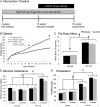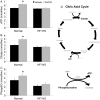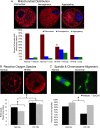Obesity-induced oocyte mitochondrial defects are partially prevented and rescued by supplementation with co-enzyme Q10 in a mouse model
- PMID: 27432748
- PMCID: PMC4991662
- DOI: 10.1093/humrep/dew181
Obesity-induced oocyte mitochondrial defects are partially prevented and rescued by supplementation with co-enzyme Q10 in a mouse model
Abstract
Study question: Does supplementation with co-enzyme Q10 (CoQ10) improve the oocyte mitochondrial abnormalities associated with obesity in mice?
Summary answer: In an obese mouse model, CoQ10 improves the mitochondrial function of oocytes.
What is known already: Obesity impairs oocyte quality. Oocytes from mice fed a high-fat/high-sugar (HF/HS) diet have abnormalities in mitochondrial distribution and function and in meiotic progression.
Study design, size, duration: Mice were randomly assigned to a normal, chow diet or an isocaloric HF/HS diet for 12 weeks. After 6 weeks on the diet, half of the mice receiving a normal diet and half of the mice receiving a HF/HS diet were randomly assigned to receive CoQ10 supplementation injections for the remaining 6 weeks.
Participants/materials, setting, methods: Dietary intervention was initiated on C57Bl6 female mice at 4 weeks of age, CoQ10 versus vehicle injections were assigned at 10 weeks, and assays were conducted at 16 weeks of age. Mice were super-ovulated, and oocytes were collected and stained to assess mitochondrial distribution, quantify reactive oxygen species (ROS), assess meiotic spindle formation, and measure metabolites. In vitro fertilization was performed, and blastocyst embryos were transferred into control mice. Oocyte number, fertilization rate, blastulation rate and implantation rate were compared between the four cohorts. Bivariate statistics were performed appropriately.
Main results and the role of chance: HF/HS mice weighed significantly more than normal diet mice (29 versus 22 g, P< 0.001). CoQ10 supplementation did not influence weight. Levels of ATP, citrate, and phosphocreatine were lower and ROS levels were higher in HF/HS mice than in controls (P< 0.001). CoQ10 supplementation significantly increased the levels of metabolites and decreased ROS levels in oocytes from normal diet mice but not in oocytes from HF/HS mice. However, CoQ10 completely prevented the mitochondrial distribution abnormalities observed in the HF/HS mice. Overall, CoQ10 supplementation significantly increased the percentage of normal spindle and chromosome alignment (92.3 versus 80.2%, P= 0.039). In the sub-analysis by diet, the difference did not reach statistical significance. When undergoing IVF, there were no statistically significant differences in the number of mature oocytes, the fertilization rate, blastocyst formation rates, implantation rates, resorption rates or litter size between HF/HS mice receiving CoQ10 or vehicle injections.
Limitations, reasons for caution: Experiments were limited to one species and strain of mice. The majority of experiments were performed after ovulation induction, which may not represent natural cycle fertility.
Wider implications of the findings: Improvement in oocyte mitochondrial distribution and function of normal, chow-fed mice and HF/HS-fed mice demonstrates the importance of CoQ10 and the efficiency of the mitochondrial respiratory chain in oocyte competence. Clinical studies are now needed to evaluate the therapeutic potential of CoQ10 in women's reproductive health.
Study funding/competing interests: C.E.B. received support from the National Research Training Program in Reproductive Medicine sponsored by the National Institute of Health (T32 HD040135-13) and the Scientific Advisory Board of Vivere Health. K.H.M received support from the American Diabetes Association and the National Institute of Health (R01 HD083895). There are no conflicts of interest to declare.
Trial registration number: This study is not a clinical trial.
Keywords: antioxidant; co-enzyme Q10; electron transport complex; mitochondria; obesity; oocyte quality; spindle and chromosome alignment.
© The Author 2016. Published by Oxford University Press on behalf of the European Society of Human Reproduction and Embryology. All rights reserved. For Permissions, please email: journals.permissions@oup.com.
Figures



Similar articles
-
Obese outbred mice only partially benefit from diet normalization or calorie restriction as preconception care interventions to improve metabolic health and oocyte quality.Hum Reprod. 2022 Nov 24;37(12):2867-2884. doi: 10.1093/humrep/deac226. Hum Reprod. 2022. PMID: 36342870
-
Mitochondria-targeted therapy rescues development and quality of embryos derived from oocytes matured under oxidative stress conditions: a bovine in vitro model.Hum Reprod. 2019 Oct 2;34(10):1984-1998. doi: 10.1093/humrep/dez161. Hum Reprod. 2019. PMID: 31625574
-
A pre-in vitro maturation medium containing cumulus oocyte complex ligand-receptor signaling molecules maintains meiotic arrest, supports the cumulus oocyte complex and improves oocyte developmental competence.Mol Hum Reprod. 2017 Sep 1;23(9):594-606. doi: 10.1093/molehr/gax032. Mol Hum Reprod. 2017. PMID: 28586460
-
The Effect of CoQ10 supplementation on ART treatment and oocyte quality in older women.Hum Fertil (Camb). 2023 Dec;26(6):1544-1552. doi: 10.1080/14647273.2023.2194554. Epub 2023 Apr 27. Hum Fertil (Camb). 2023. PMID: 37102567 Review.
-
Does Coenzyme Q10 Supplementation Improve Human Oocyte Quality?Int J Mol Sci. 2021 Sep 2;22(17):9541. doi: 10.3390/ijms22179541. Int J Mol Sci. 2021. PMID: 34502447 Free PMC article. Review.
Cited by
-
Body mass index is associated with miscarriage rate and perinatal outcomes in cycles with frozen-thawed single blastocyst transfer: a retrospective cohort study.BMC Pregnancy Childbirth. 2022 Feb 11;22(1):118. doi: 10.1186/s12884-022-04443-2. BMC Pregnancy Childbirth. 2022. PMID: 35148705 Free PMC article.
-
Algal and Fungal Antioxidants Alleviate Oxidative Stress-Induced Reproductive Defects.Food Sci Nutr. 2025 May 16;13(5):e70301. doi: 10.1002/fsn3.70301. eCollection 2025 May. Food Sci Nutr. 2025. PMID: 40384992 Free PMC article. Review.
-
Pregnancy in obese women and mechanisms of increased cardiovascular risk in offspring.Eur Heart J. 2024 Dec 23;45(48):5127-5145. doi: 10.1093/eurheartj/ehae671. Eur Heart J. 2024. PMID: 39508438 Free PMC article. Review.
-
Coenzyme Q10 Stimulate Reproductive Vatality.Drug Des Devel Ther. 2023 Aug 30;17:2623-2637. doi: 10.2147/DDDT.S386974. eCollection 2023. Drug Des Devel Ther. 2023. PMID: 37667786 Free PMC article. Review.
-
Transcripts encoding free radical scavengers in human granulosa cells from primordial and primary ovarian follicles.J Assist Reprod Genet. 2018 Oct;35(10):1787-1798. doi: 10.1007/s10815-018-1240-3. Epub 2018 Jun 29. J Assist Reprod Genet. 2018. PMID: 29959620 Free PMC article.
References
-
- Balaban RS, Nemoto S, Finkel T. Mitochondria, oxidants, and aging. Cell 2005;120:483–495. - PubMed
-
- Bellone M, Zuccotti M, Redi CA, Garagna S. The position of the germinal vesicle and the chromatin organization together provide a marker of the developmental competence of mouse antral oocytes. Reproduction 2009;138:639–643. - PubMed
-
- Bellver J, Busso C, Pellicer A, Remohi J, Simon C. Obesity and assisted reproductive technology outcomes. Reprod BioMed Online 2006;12:562–568. - PubMed
-
- Ben-Meir A, Yahalomi S, Moshe B, Shufaro Y, Reubinoff B, Saada A. Coenzyme Q-dependent mitochondrial respiratory chain activity in granulosa cells is reduced with aging. Fertil Steril 2015. b;104:724–727. - PubMed
Publication types
MeSH terms
Substances
Grants and funding
LinkOut - more resources
Full Text Sources
Other Literature Sources
Medical
Research Materials
Miscellaneous

